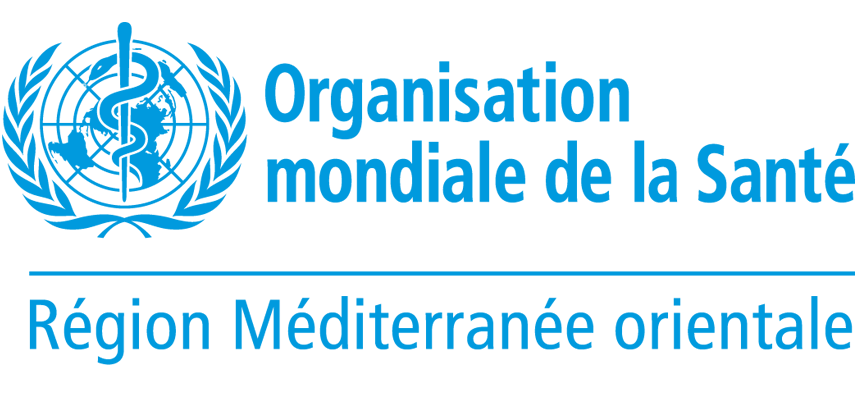WHO steps up humanitarian operations for drought response: introducing emergency and critical care services as part of integrated service delivery at the primary heath care level
 WHO Somalia12 June 2022 – At the busy Midnimo District Hospital in Abudwaq, a nurse and her two assistants take shifts to sit at a desk to assess the patients who come in. The nurse has been trained by WHO to deliver basic emergency care and to observe the patients and ask their caregivers or the patients themselves – if they can speak – key questions about their conditions. Dr Siyad Mohamed Abdi, a general surgeon who serves as the director of the hospital, and his medical staff come in during their shifts to oversee activities at the desk, known as the triage corner.
WHO Somalia12 June 2022 – At the busy Midnimo District Hospital in Abudwaq, a nurse and her two assistants take shifts to sit at a desk to assess the patients who come in. The nurse has been trained by WHO to deliver basic emergency care and to observe the patients and ask their caregivers or the patients themselves – if they can speak – key questions about their conditions. Dr Siyad Mohamed Abdi, a general surgeon who serves as the director of the hospital, and his medical staff come in during their shifts to oversee activities at the desk, known as the triage corner.
The hospital staff have witnessed several health emergencies in the Galgadud region, with the protracted conflict adding another layer of complexity to the mix. This means that mass casualties are a common sight.
With the ongoing drought, which has affected 6.13 million people in Somalia, and with Galgadud being a particularly arid region with no access to major rivers, additional patients are streaming in through the doors of the hospital. Every day, around 20–75 patients come in, sometimes from towns along the Somali and Ethiopian border. Many are so overwhelmed attending to their families’ dire needs due to the drought that it is often very late by the time they arrive for medical support.
Triage corners help staff to give urgent attention to those patients with emergency health conditions who need it first and the most. With assistance from WHO, the Federal Ministry of Health and Human Services and other partners, Midnimo District Hospital has been able to set up the triage corner to sort and prioritize patients with emergency health conditions that require urgent medical intervention. Progress is underway to set up similar efficient and effective triage corners in another 71 health facilities in drought-affected districts of Somalia, with equipment already delivered to most of the facilities.
One of the biggest lessons of the COVID-19 pandemic has been that safe access to health care that is close to home for early diagnosis and intervention, including targeted referral to higher levels of care for severe illness, is as important as specialized care at the higher levels of the health service delivery system. In this way, the resources of both the primary and secondary levels of care are optimized as a continuum of care within an integrated health service delivery system. This approach has been essential for maintaining essential health services during the recent drought.
The triage corners being set up within district hospitals will help to build the foundations for introducing emergency and critical care services at the primary health care level across Somalia. Emergency health conditions form a substantial proportion of the overall disease burden in the country and the drought may be exacerbating many of these conditions. WHO is supporting health facility preparedness and the building of a strong and resilient health system through the emergency response to the COVID-19 pandemic and the current drought.
Using triage corners to prioritize patients
While describing how things used to work before at the emergency ward at Midnimo District Hospital, Dr Mohamed explains, “Before, we would take in patients on a first-come, first-served basis, which meant those in need would wait unnecessarily for more casual cases to receive attention. These delays were sometimes dangerous.”
However, since WHO, the Federal Ministry of Health and Human Services and other partners intervened, Dr Mohamed and his team feel much better prepared to manage patients with emergency conditions. Between December 2020 and 2021, Dr Mohamed and two of his colleagues participated in capacity-development in mass casualty management organized by WHO with the support of the World Bank. Through this support, nurses, doctors and anaesthetists from around Somalia learnt how to organize and support patients as they arrive at health facilities through the establishment of a triage system.
Now, at Midnimo District Hospital, at the triage corner, the patients with the most serious conditions, or ‘red’ patients are admitted to the emergency ward. The ones who are able to wait — the ‘orange’ or ‘yellow’ patients — are escorted to the casualty ward.
“We are careful to screen and treat children, especially the under-5s, who are experiencing medical complications as a result of severe acute malnutrition and serious levels of diarrhoea, without delay. At the triage corner, we are ensuring they receive immediate attention, as they are so delicate and a few minutes can mean a matter of life or death,” added Dr Mohamed. He explained that children with these conditions were treated as ‘red’ patients.
The triage corner has helped Dr Mohamed and his team to be more efficient and organized, saving both time and lives, and limited resources. After seeing its benefits, he feels every hospital, particularly in an under-resourced country like Somalia, which has recurring health emergencies, should have triage corners.
Triage corners save lives
A few weeks ago, a family of eight rushed to Midnimo District Hospital with three young girls who were severely dehydrated. After assessing their dehydration status, the team at the triage corner informed Dr Mohamed about their serious condition, and they were admitted to the paediatric ward immediately. The doctor set up intravenous drips for each of them to receive infusions for rehydration, since they were severely dehydrated (category C). When he saw their condition, Dr Mohamed was not sure if they would survive but, as always, he tried his best to manage their conditions, keeping alive the hope he always has for his patients.
After a few days of managing their condition, the three girls were discharged. A few days later, their father returned with a goat. He explained that he did not have much to offer Dr Mohamed but insisted he accept the goat as a token of his appreciation for saving his daughters’ lives, despite Dr Mohamed attempts to persuade him that this was not required.
Dr Mohamed and his team were really touched with this kind gesture. He decided to sell the goat and bought supplies for other patients with urgent needs at the hospital.
Setting up triage corners in more hospitals
So far, WHO has collaborated with the Ministry of Health and Human Services to set up triage corners in two hospitals in the Galmudug State – in Abudwaq and Dhushamareb. WHO and the Federal and State ministries of health are working together to equip Midnimo District Hospital and other triage corners and emergency wards in hospitals with biomedical equipment. This includes oxygen concentrators, oximeters, stethoscopes, nasal cannulas and oxygen masks.
Progress is underway to set up similar triage corners in other health facilities in drought-affected districts of Somalia, and equipment has already been delivered to most of the facilities. Instruction in the use of biomedical equipment is currently underway.
“Thanks to support from the Central Emergency Response Fund (CERF), the European Union and WHO’s Contingency Fund for Emergencies (CFE), and other partners, WHO and the Ministry of Health have been able to save many lives by addressing the needs of patients who require life-saving, timely support. We are helping health facilities and their workforce to use efficient ways of working, such as triage corners, which have a high impact on saving lives. However, we still need additional support to scale up the capacity of more hospitals across Somalia to offer the same efficient services,” said Dr Mamunur Malik, WHO Representative to Somalia and Head of Mission.
For additional information on WHO’s response to the drought, please see:
WHO scales up operations to save lives from cholera and other waterborne diseases
WHO scales up operations to save lives from cholera and other waterborne diseases
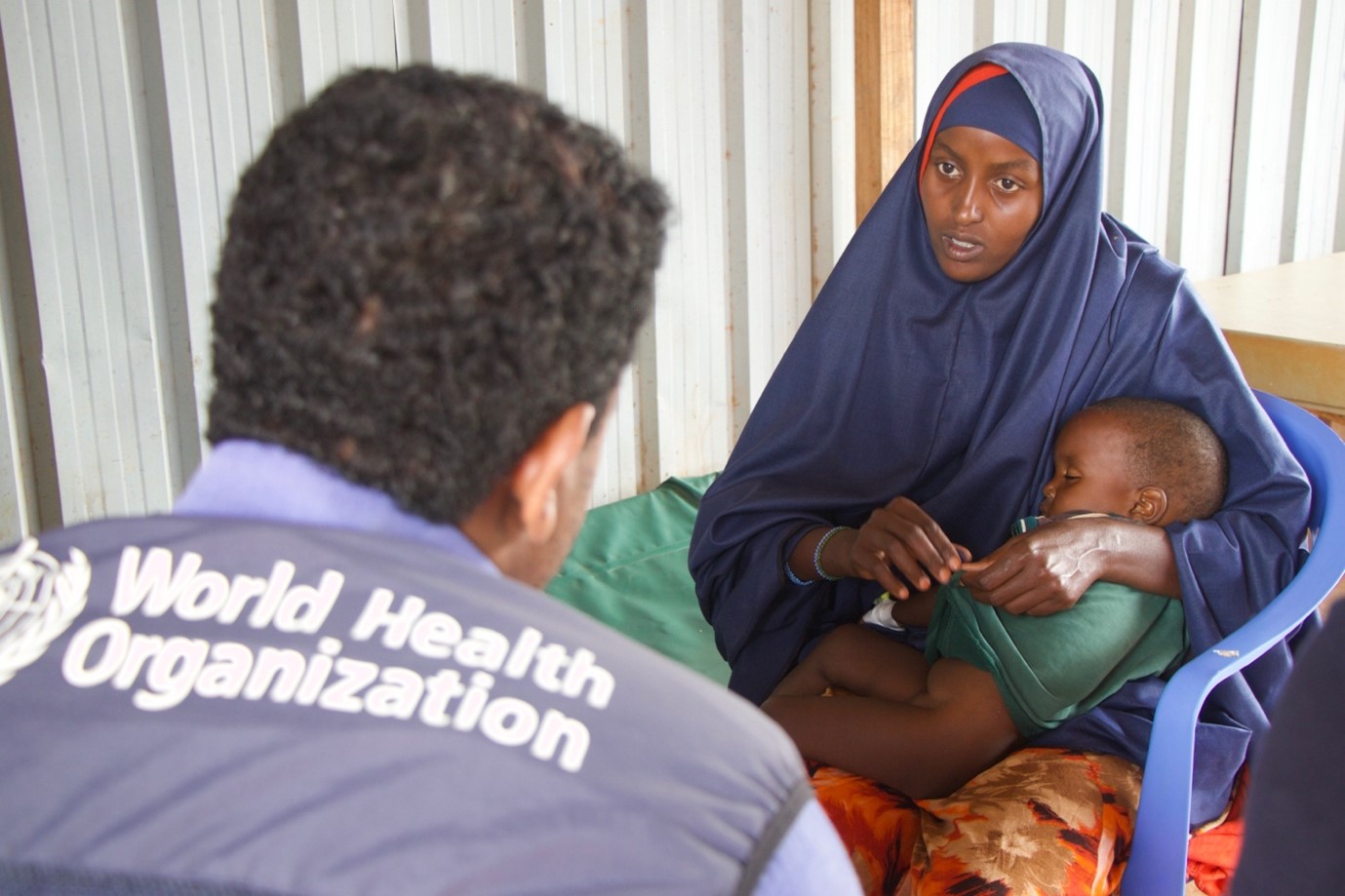 A public health officer discussing supplies at the oral rehydration therapy corner at the Bayhow cholera treatment centre. Credit: WHO Somalia/Dhal Hassan9 June 2022 – At the cholera treatment centre in the Bayhow General Hospital in Baidoa, Dr Abdirahman Isack Mohamed sighs when he explains some of the gruelling effects of the lingering drought. Between March and April 2022, the hospital was attending to 40–50 cases of cholera a week. Even though the number is down to 5–10 per week this month, the situation is still very severe.
A public health officer discussing supplies at the oral rehydration therapy corner at the Bayhow cholera treatment centre. Credit: WHO Somalia/Dhal Hassan9 June 2022 – At the cholera treatment centre in the Bayhow General Hospital in Baidoa, Dr Abdirahman Isack Mohamed sighs when he explains some of the gruelling effects of the lingering drought. Between March and April 2022, the hospital was attending to 40–50 cases of cholera a week. Even though the number is down to 5–10 per week this month, the situation is still very severe.
A few weeks ago, late one night, a young man rushed in and admitted a 60-year-old woman with severe dehydration from a camp for internally displaced persons to the hospital. Her caregiver explained she had had a serious bout of diarrhoea and vomiting, and then fainted. He also added that the old lady had been using water from an unprotected shallow well to cook and for hygiene. With the ongoing drought, around 3.5 million people lack sufficient access to water and risk contracting waterborne diseases.
At the cholera treatment centre, after a quick diagnosis and assessment of the dehydration status, Dr Mohamed and his team gave her immediate support, which helped her to gain consciousness. She recovered within a few days, after receiving intravenous (IV) fluids through the bloodstream and then oral rehydration salts (ORS) that she could drink.
WHO supports cholera treatment centres to manage patients with cholera infection
“WHO, the Ministry of Health and other partners have helped us to strengthen and refresh our skills for case management of cholera infections. They trained us to assess dehydration and manage cholera infections, as well as other waterborne diseases. They have also helped us in infection prevention and control, which has enabled us to protect patients and health workers,” said Dr Mohamed.
With support from WHO and partners, medical staff at 3 hospitals – the Bayhow General Hospital in Baidoa and Marka Hospital and Afgoye cholera treatment centres — are able to provide the right treatment and support to patients suffering from acute watery diarrhoea and cholera. The health workers are managing cholera cases and demonstrating to patients proper hygiene practices, including hand washing and safe sanitation practices. They also teach patients how to manage domestic waste within their households, sanitize latrines and use water purification tablets to purify and preserve safe drinking-water at home. All these measures have significantly reduced the spread of waterborne diseases like cholera in the South West state, which has the highest number of cholera infections reported from the country thus far.
Since 2021, WHO has developed the technical capacity through training 45 health workers, including 12 medical staff, such as Dr Mohamed, at these 3 centres in the South West State. WHO has also equipped these major hospitals with essential supplies and medicines for case management of cholera and other waterborne diseases.
Oral rehydration treatment corners offering life-saving measures
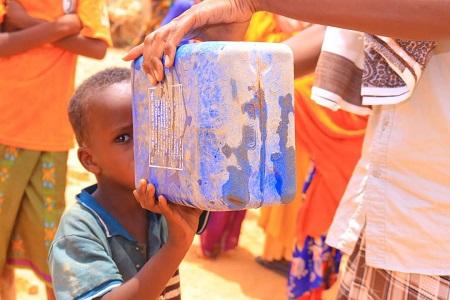 Access to clean water is limited during the ongoing drought in Somalia, which increases the risk of cholera and other waterborne infections in camps for internally displaced persons. Credit: WHO Somalia/Mukhtar Sudani Oral rehydration therapy (ORT) corners are an important life-saving strategy that prevent mortality in children due to dehydration from diarrhoeal diseases. WHO is collaborating with health facilities to set up 63 ORT corners across 24 drought-affected districts that WHO is currently supporting for drought response. In Baidoa, so far, WHO has set up ORT corners in 6 health centres to offer life-saving treatment for children with diarrhoea.
Access to clean water is limited during the ongoing drought in Somalia, which increases the risk of cholera and other waterborne infections in camps for internally displaced persons. Credit: WHO Somalia/Mukhtar Sudani Oral rehydration therapy (ORT) corners are an important life-saving strategy that prevent mortality in children due to dehydration from diarrhoeal diseases. WHO is collaborating with health facilities to set up 63 ORT corners across 24 drought-affected districts that WHO is currently supporting for drought response. In Baidoa, so far, WHO has set up ORT corners in 6 health centres to offer life-saving treatment for children with diarrhoea.
ORT corners are equipped with ORS and other useful equipment to assess the dehydration status of children presenting symptoms of diarrhoeal diseases. The early treatment, and follow up offered by trained health workers, is saving children from dying due to severe dehydration. Trained health workers in each corner provide ORS and treatment for children with moderate dehydration, while keeping a watchful eye over them to prevent severe dehydration. When the affected children’s conditions improve, the health workers give their mothers ORS and teach them how to prepare home-made ORS. They advise mothers to visit a health facility nearby if the child’s condition deteriorates and encourage mothers to continue breastfeeding if children are young.
Time is of the essence in curbing cholera spread
“Time is of the essence in our response to the ongoing drought, including in managing diseases like cholera,” said Dr Mamunur Rahman Malik, WHO Representative to Somalia. “WHO has been providing urgent, life-saving support to cholera treatment centres around Somalia to save the lives of patients infected with cholera. We have over 452 community health workers explaining to communities in 6 affected districts of South West State how to prevent the spread of acute diarrhoeal diseases and suspected cholera.”
The Head of Mission at WHO Somalia added, “Furthermore, we are teaming up with the Ministry of Health and Human Services and partners to conduct a cholera vaccination campaign to protect over 900 000 people from cholera. As of May 2022, Somalia has had 4887 suspected cholera cases, including 16 deaths, reported in 21 of 74 drought-affected districts in Somalia. Cholera remains endemic in Somalia with repeated outbreaks occurring in localized areas. Approximately 62% of the cholera cases were among children under 5, while around half of the cases were females.”
An estimated 49% of the population – 7.7 million people – require some form of humanitarian or protection assistance in Somalia. Overall, 6.13 million of these people are estimated to be affected by the current drought.
WHO’s current drought response operations, including its critical life-saving support, is funded by the Central Emergency Response Fund (CERF), the European Union (EU) Delegation to Somalia, and WHO’s Contingency Fund for Emergencies (CFE).
Ending polio in Somalia: children vaccinated in national immunization day
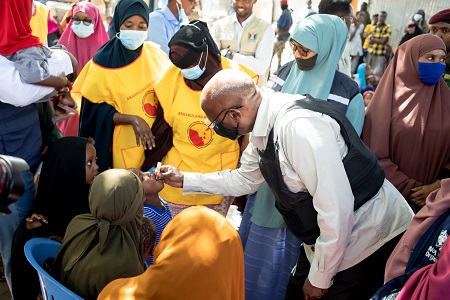 7 June 2022 – On 6 June 2022, the WHO Representative in Somalia Dr Mamunur Rahman Malik was joined by the UNICEF Country Representative Ms Angela Kearney, the Governor and Mayor of Mogadishu HE Omar Mohamed Mohamud Flish and Deputy Special Representative of the Secretary General and the United Nations Resident and Humanitarian Coordinator for Somalia Mr Adam Abdelmoula to officially launch the national immunization day for polio in Somalia. They visited a camp for internally displaced persons in Manahijta and Waberi health centre in Banadir city, to officially launch the national immunization day and vaccinate children against polio.
7 June 2022 – On 6 June 2022, the WHO Representative in Somalia Dr Mamunur Rahman Malik was joined by the UNICEF Country Representative Ms Angela Kearney, the Governor and Mayor of Mogadishu HE Omar Mohamed Mohamud Flish and Deputy Special Representative of the Secretary General and the United Nations Resident and Humanitarian Coordinator for Somalia Mr Adam Abdelmoula to officially launch the national immunization day for polio in Somalia. They visited a camp for internally displaced persons in Manahijta and Waberi health centre in Banadir city, to officially launch the national immunization day and vaccinate children against polio.
The ongoing immunization campaign for polio is targeting close to 3.5 million children under 5 in the country, except Puntland and Somaliland. The first round of the campaign against polio was held in March and close to 95% of the 3.5 million children under 5 received an oral polio vaccine during the first round.
Somalia has remained free from circulation of wild polio virus since 2015. However, the country was affected by another type of polio virus called circulating vaccine-derived polio virus type 2 (cVDPV2) that has continued to circulate in Somalia since 2017 causing paralysis and disability to a number of children in the country.
“The outbreak of polio caused by vaccine-derived type 2 and type 3 virus has led to permanent paralysis and disability to 32 children so far. This means that these children cannot run, walk or play as they should be able to. It also means that 26 families have been going through immense suffering – both socially and financially. Ending polio in Somalia and the rest of the world is a moral imperative for us. We aim for every child being born today to lead a healthy life and have equal access to health services. In this interconnected and globalized world, the threat of polio in one country is a threat everywhere,” said Mr Adam Abdelmoula, Deputy Special Representative of the Secretary General and the United Nations Resident and Humanitarian Coordinator for Somalia, after vaccinating the children against polio and formally opening the national immunization day for polio.
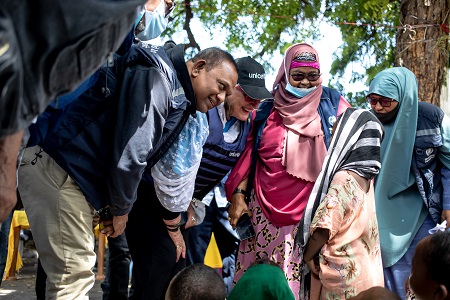 The vaccine-derived poliovirus circulates in a setting where the routine immunization of childhood vaccination for polio is low and as a result the immunity of children against polio remains low. The transmission of this new type of polio virus is entrenched in the central and southern parts of Somalia, with spillover resulting in cross- border transmission in northern Somalia, Kenya and Ethiopia.
The vaccine-derived poliovirus circulates in a setting where the routine immunization of childhood vaccination for polio is low and as a result the immunity of children against polio remains low. The transmission of this new type of polio virus is entrenched in the central and southern parts of Somalia, with spillover resulting in cross- border transmission in northern Somalia, Kenya and Ethiopia.
Inaccessibility is also a significant constraint to reaching every child in the country. There are some other compounding factors like regular population movement within and between the inaccessible areas and refugee camps in Somalia and neighbouring countries (mainly Kenya) that are pushing back progress.
“The main problem in not being able to stop the circulation of this type of polio virus in the country is the inability of the fragile health sector to reach and vaccinate all children, especially the “zero-dose” children who have never been vaccinated and have no immunization shield to protect them. These national immunization days provide an opportunity to look for every last child and vaccinate them with an oral polio drop. We are hopeful that the country will be able to defeat this virus and the debilitating disease it causes by working together and making sure we use speed and precision to vaccinate all children targeted for such campaigns against polio and measles, said Dr Sk Md Mamunur Rahman Malik, WHO Representative in Somalia.
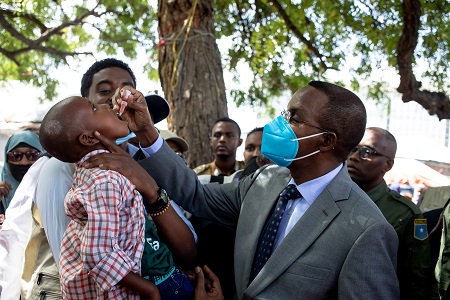 WHO and UNICEF are supporting the Government to organize these national immunization days as an accelerated way and means of reaching and vaccinating every last child against polio. All districts in the south and central parts of Somalia, except Somaliland and Puntland, are being covered by the second round of national immunization days using monovalent oral polio vaccine type 2 (mOPV2) from 5 to 8 June 2022 as a part of interrupting cVDPV2 and stopping the outbreak. After much groundwork, including microplanning, team training and logistic preparation, more than 20 664 polio vaccinators with registers traversing the country on foot, and by car, camel and donkey, knocking on doors and working tirelessly to reach as many children as possible during the campaign. More than 4090 supervisors from the Ministry of Health, WHO, UNICEF will be monitoring the quality of the campaigns while 10 333 social mobilizers, together with 146 regional and district social mobilization coordinators, will be visiting house to house to explain the immense benefits for children when they receive the polio vaccine and encourage parents to bring their children to a nearby health centre to vaccinate against polio if they are not reached by vaccinators moving house to house.
WHO and UNICEF are supporting the Government to organize these national immunization days as an accelerated way and means of reaching and vaccinating every last child against polio. All districts in the south and central parts of Somalia, except Somaliland and Puntland, are being covered by the second round of national immunization days using monovalent oral polio vaccine type 2 (mOPV2) from 5 to 8 June 2022 as a part of interrupting cVDPV2 and stopping the outbreak. After much groundwork, including microplanning, team training and logistic preparation, more than 20 664 polio vaccinators with registers traversing the country on foot, and by car, camel and donkey, knocking on doors and working tirelessly to reach as many children as possible during the campaign. More than 4090 supervisors from the Ministry of Health, WHO, UNICEF will be monitoring the quality of the campaigns while 10 333 social mobilizers, together with 146 regional and district social mobilization coordinators, will be visiting house to house to explain the immense benefits for children when they receive the polio vaccine and encourage parents to bring their children to a nearby health centre to vaccinate against polio if they are not reached by vaccinators moving house to house.
Note to editors
Polio is a highly infectious disease caused by a virus that mainly affects children under the age of 5. It invades the nervous system and can cause paralysis or even death. While there is no cure for polio, vaccination is the only effective way to protect our children from the crippling disease. Every time children under the age of 5 get the polio vaccine, they are more protected. Such repeated immunizations have protected millions of children from polio and made many countries polio free. The national immunization days for polio and keeping countries polio free are supported by the Global Polio Eradication Initiative, which is a public-private partnership led by national governments with 6 core partners – the World Health Organization (WHO), Rotary International, the US Centers for Disease Control and Prevention (CDC), the United Nations Children’s Fund (UNICEF), the Bill & Melinda Gates Foundation and Gavi - the Vaccine Alliance. Its goal is to eradicate polio worldwide.
For additional information, please contact:
Dr Ali M. Bin Break
Medical Officer and acting Team Lead
Polio Eradication Programme
WHO Somalia
Kyle DeFreitas, Lead External Relations
WHO Somalia
Fouzia Bano
Communications Officer/Chief of Staff a.i.,
WHO Somalia
Stepping up humanitarian operations for drought: WHO’s support to the stabilization centres is saving lives
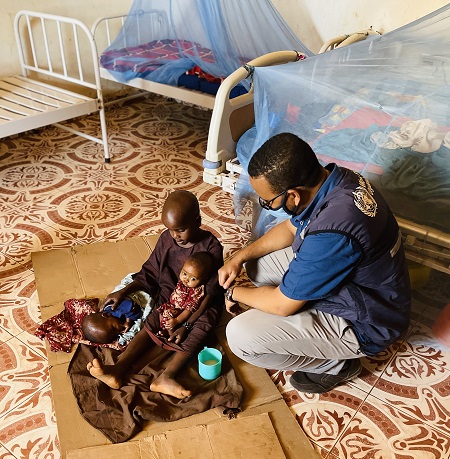 WHO has been supporting the Government with life-saving supplies for children with severe acute malnutrition and medical complications (Baidoa, 2022). Credit: WHO/Somalia
WHO has been supporting the Government with life-saving supplies for children with severe acute malnutrition and medical complications (Baidoa, 2022). Credit: WHO/Somalia
30 May 2022 – Fatima Ahmed Ali and her one-year-old son Abdullahi are just two of many Somalis whose lives have changed due to the ongoing drought in Somalia. This drought is reported to be one of the worst in recent history. Yet, they are among the lucky ones to have received timely medical attention.
Living as a pastoralist in a rural area in Gardo, Puntland, Fatima says they are used to seeing droughts come and go, but this one has been severe. Neighbours are trying to help each other as families are losing all their livestock, while children everywhere are suffering from diseases, many of which are preventable. Several families have no money to support their loved ones, and some do not know where to go if they have nutrition-related health problems, she explains.
Stabilization centres address complications
In April 2022, when Abdullahi fell really ill, a family member took Fatima and her son to a health centre nearby, in Yako. From there, a health worker directed them to the Gardo Stabilization Centre for specialized attention.
At stabilization centres like the one Fatima visited, trained health workers assess the condition of patients, particularly those who are suffering from severe acute malnutrition with medical complications. They stabilize the condition of these severely acutely malnourished children with appropriate feeding, micronutrient supplementation, correction of dehydration status, and appropriate treatment and care for medical complications. WHO is supporting 53 such stabilization centres across the country to treat severely acute malnourished children with medical complications. WHO’s support includes training of health care workers on the clinical management of patients and organization of stabilization centres, provision of appropriate medical supplies, such as the severe acute malnutrition kits, and ensuring and monitoring quality of care. In 2021, a total of 14 430 children under 5 received treatment in these stabilization centres, with a 95% cure rate.
“Abdullahi was not eating at all before we got here. He had a fever and could not even sleep. I felt really helpless,” said Fatima. “I am grateful for the support he received at the stabilization centre. After taking medication, Abdullahi was able to rest and eat again.”
Fatima hopes to see conditions improve in Somalia, where every year communities face natural disasters. WHO’s support to these stabilization centres is saving the lives of thousands of malnourished children who have had medical complications in Somalia, like the son of Fatima.
WHO provides life-saving critical support to save lives
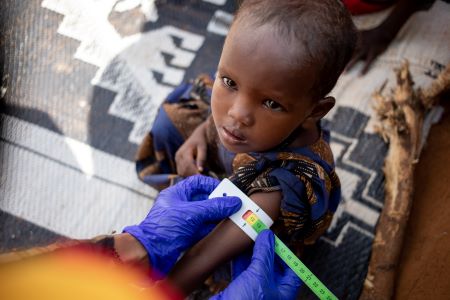 Credit: WHO/SomaliaThe current food insecurity situation in Somalia owing to drought continues to worsen. Four consecutive failed rainy seasons and increasing economic pressures are deepening the severity of needs and driving the country to the brink of famine. An estimated 49% of the population – 7.7 million people – require some form of humanitarian or protection assistance, of whom 6.13 million are estimated to be affected by the drought.
Credit: WHO/SomaliaThe current food insecurity situation in Somalia owing to drought continues to worsen. Four consecutive failed rainy seasons and increasing economic pressures are deepening the severity of needs and driving the country to the brink of famine. An estimated 49% of the population – 7.7 million people – require some form of humanitarian or protection assistance, of whom 6.13 million are estimated to be affected by the drought.
Of these 6.1 million people across the country who are food insecure, including nearly 1.7 million who are suffering from extreme levels of hunger, an estimated 1.4 million children under 5 and more than 250 000 pregnant and lactating women will need treatment and care for malnutrition.
WHO’s current drought response operations, including its critical life-saving support is funded by the Central Emergency Response Fund (CERF), the European Union and WHO’s Contingency Fund for Emergencies (CFE).
At the household level, due to the ongoing drought in Somalia, WHO supports community health workers to visit families to determine who needs urgent support. In drought-affected areas, they measure the circumference of children’s upper arms to assess their levels of malnourishment, and whether they need to visit stabilization centres for medical attention.
“Currently, 1.4 million Somali children are known to be acutely malnourished. The support we are providing has reduced the number of deaths caused by medical complications related to severe acute malnutrition. We have also stepped up our life-saving critical support while responding to this drought, such as expanding access to essential health and nutrition services at the community and primary health centre level, as well as keeping a vigilant eye on diseases that are evolving in epidemic proportions and containing them at source. However, WHO has a funding gap of close to US$ 39 million between now and the end of the year to support, maintain and scale up our life-saving operations. Closing this gap will mean that we are able to prevent excess deaths in a fragile setting suffering one of the worst humanitarian crises in their lifetime,” said Dr Mamunur Rahman Malik, WHO Representative to Somalia and Head of Mission.
